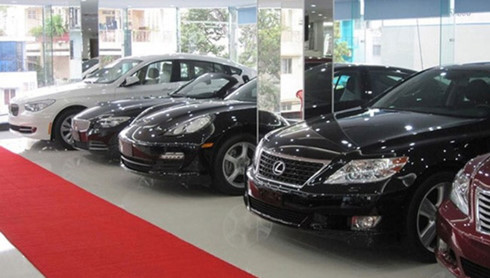Vietnam’s automobile market to be flooded with zero-tariff ASEAN cars
 |
Thailand and Indonesia could earn billions of dollars each year as their cars shipped to Vietnam make up 80% of the total car imports in the country so far this year thanks to the zero-tariff policy under the ASEAN Free Trade Area since 2018.
The General Department of Vietnam Customs’ statistics revealed that in the first five months of 2019, Vietnam spent some US$1.42 billion to import completely built-up (CBU) automobiles from overseas, a robust rise compared to the previous year.
Thailand ranked first in the list of CBU cars exporters to Vietnam with 38,386 units, earning US$726 million, followed by Indonesia with 19,477 cars worth US$276 million.
Thanks to the removal of tariff on autos among ASEAN members, the CBU cars from these neighboring countries have taken the upper hand in the market and fiercely compete with domestic automobiles.
Despite having debuted in Vietnam only almost a year ago, some SUV-cum-MPV models, including Mitsubishi Xpander and Toyota Rush (or Honda BR-V), have dominated the market in this new segment with thousands of vehicles sold every month and demand for these models continues to rise.
In the small-sized car market, the A-class segment has seen a cutthroat competition between the imported Toyota Wigo and Honda Brio and the domestically assembled Hyundai i10 and Kia Morning.
Vietnamese demand for cars still rises steadily, however, the cars assembled in Vietnam are in the disadvantageous position. According to the Vietnam Automobile Manufacturers Association (VAMA)’s reports, the total car sales in the first five months of 2019 reached 111,497 vehicles, up 18% year-on-year, of which passenger cars amounted to 89,591 cars, up 33% year-on-year.
However, the sales of cars assembled in Vietnam fell by 14% while imported car sales jumped by 210% year-on-year.
Might Thailand and Indonesia reap benefits?
The rising number of imported cars prevents domestic automakers from raising output. The Thaco-Mazda factory in Quang Nam province opened in 2018 with an expected capacity of 50,000 cars per year in its first phase. However, its output only reached 30,000 cars last year.
Mazda has not yet proceeded with the second phase to increase its capacity to 120,000 vehicles per year as planned.
According to the Vietnam Ministry of Industry and Trade’s (MoIT), the localization rate of the domestic automobile industry averaged only about 7-10%, so the target of reaching localization rate of 40% in 2005 and 60% in 2010 definitely failed due to weak supporting industries and low technologies. Still 80 to 90% of input materials to make auto parts have to be imported.
The automobile market is predicted to thrive when Vietnam’s GDP per capita reaches US$3,000 from US$2,600 in 2018.
Car sales are forecast to reach 500,000 per year from 2020 and 1 million cars per year by 2030, with a turnover of US$12 billion each year.
In order to develop the automobile industry in Vietnam in line with the goal of increasing the localization rate, the MoIT will focus on accelerating some projects of the large domestic car makers to boost the domestic production and assembly of cars in the upcoming time.
However, the opportunities for domestic market may diminish and eventually be lost to the hands of neighboring countries if some breakthrough policies were not soon issued.
Related News

Coconut is expected to become a billion-dollar export item
16:40 | 01/11/2024 Import-Export

Plastic exporters interested in converting to recycling technology
16:36 | 01/11/2024 Import-Export

Vietnam and UAE trade sees billion-dollar growth
07:15 | 03/11/2024 Import-Export
Latest News

Import and export are expected to reach 800 billion USD
13:32 | 04/11/2024 Import-Export

Fresh coconuts quenching new overseas markets
13:29 | 04/11/2024 Import-Export

Rice exports likely to set new record in 2024
13:25 | 04/11/2024 Import-Export

Vietnamese goods conquer halal market through trust and quality
09:57 | 04/11/2024 Import-Export
More News

Exporters urged to have strategies to take advantage of UKVFTA for expansion
17:33 | 03/11/2024 Import-Export

Fresh coconuts quenching new overseas markets
17:29 | 03/11/2024 Import-Export

Sharing responsibility for ensuring security and safety of the supply chain
07:13 | 03/11/2024 Import-Export

Many factors affecting tuna exports in the last months of the year
19:38 | 02/11/2024 Import-Export

Vietnam still dominates Philippine rice import
19:36 | 02/11/2024 Import-Export
Vietnam cements ties with partners to engage in global semiconductor, AI industries
19:35 | 02/11/2024 Import-Export

Aquatic exports expected to rise in year-end despite challenges
19:33 | 02/11/2024 Import-Export

Trade Defense: The Key to Success for Vietnamese Businesses
10:39 | 02/11/2024 Import-Export

Lao Cai Customs sees a triple-digit surge in export-import turnover
10:37 | 02/11/2024 Import-Export
Your care

Import and export are expected to reach 800 billion USD
13:32 | 04/11/2024 Import-Export

Fresh coconuts quenching new overseas markets
13:29 | 04/11/2024 Import-Export

Rice exports likely to set new record in 2024
13:25 | 04/11/2024 Import-Export

Vietnamese goods conquer halal market through trust and quality
09:57 | 04/11/2024 Import-Export

Exporters urged to have strategies to take advantage of UKVFTA for expansion
17:33 | 03/11/2024 Import-Export





